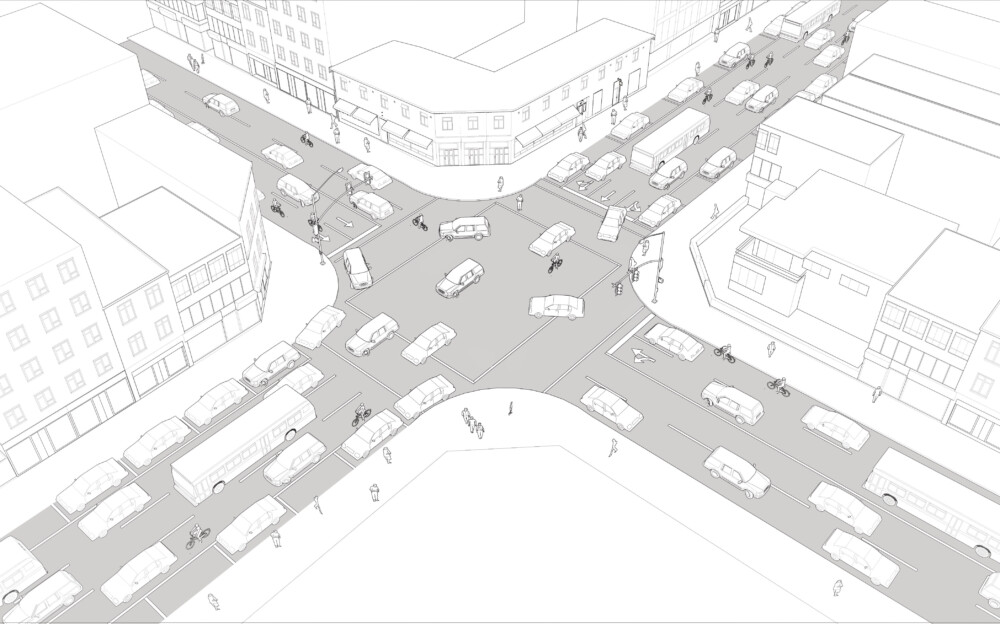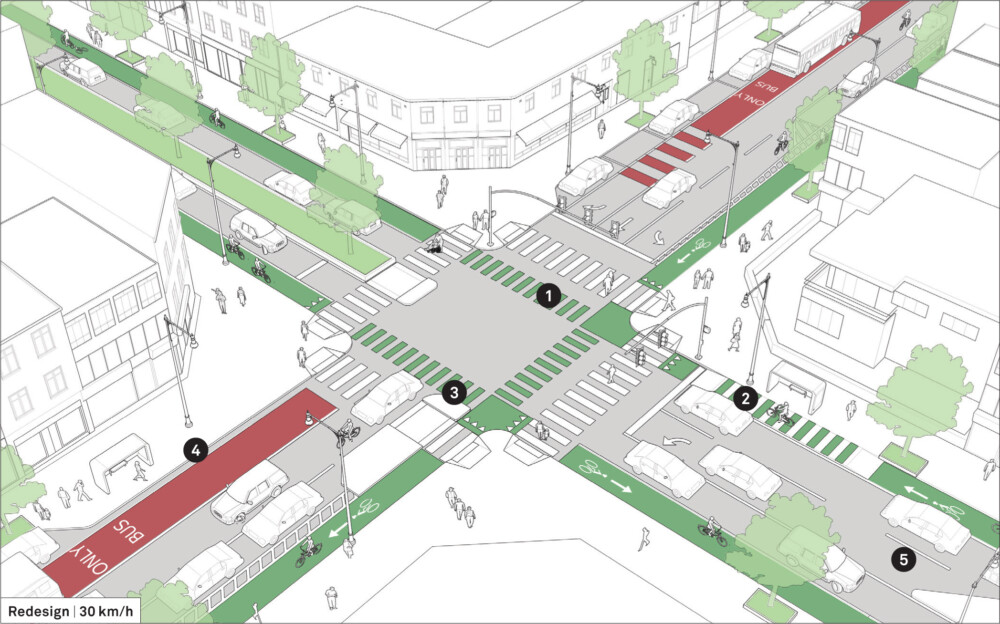-
About Streets
- Introduction
- Defining Streets
-
Shaping Streets
- The Process of Shaping Streets
- Aligning with City and Regional Agendas
- Involving the Right Stakeholders
- Setting a Project Vision
- Communication and Engagement
- Costs and Budgets
- Phasing and Interim Strategies
- Coordination and Project Management
- Implementation and Materials
- Management
- Maintenance
- Institutionalizing Change
- Measuring and Evaluating Streets
-
Street Design Guidance
- Designing Streets for Great Cities
- Designing Streets for Place
-
Designing Streets for People
- Utilities and Infrastructure
- Operational and Management Strategies
- Design Controls
-
Street Transformations
- Streets
-
Intersections
- Intersection Design Strategies
- Intersection Analysis
- Intersection Redesign
- Mini Roundabout
- Small Raised Intersection
- Neighborhood Gateway Intersection
- Intersection of Two-Way and One-Way Streets
- Major Intersection: Reclaiming the Corners
- Major Intersection: Squaring the Circle
- Major Intersection: Cycle Protection
- Complex Intersection: Adding Public Plazas
- Complex Intersection: Improving Traffic Circles
- Complex Intersection: Increasing Permeability
- Resources
Global Street Design Guide
-
About Streets
- Introduction
- Defining Streets
-
Shaping Streets
Back Shaping Streets
- The Process of Shaping Streets
- Aligning with City and Regional Agendas
- Involving the Right Stakeholders
- Setting a Project Vision
- Communication and Engagement
- Costs and Budgets
- Phasing and Interim Strategies
- Coordination and Project Management
- Implementation and Materials
- Management
- Maintenance
- Institutionalizing Change
-
Measuring and Evaluating Streets
Back Measuring and Evaluating Streets
-
Street Design Guidance
-
Designing Streets for Great Cities
Back Designing Streets for Great Cities
-
Designing Streets for Place
Back Designing Streets for Place
-
Designing Streets for People
Back Designing Streets for People
- Comparing Street Users
- A Variety of Street Users
-
Designing for Pedestrians
Back Designing for Pedestrians
- Designing for Cyclists
-
Designing for Transit Riders
Back Designing for Transit Riders
- Overview
- Transit Networks
- Transit Toolbox
-
Transit Facilities
Back Transit Facilities
-
Transit Stops
Back Transit Stops
-
Additional Guidance
Back Additional Guidance
-
Designing for Motorists
Back Designing for Motorists
-
Designing for Freight and Service Operators
Back Designing for Freight and Service Operators
-
Designing for People Doing Business
Back Designing for People Doing Business
-
Utilities and Infrastructure
Back Utilities and Infrastructure
- Utilities
-
Green Infrastructure and Stormwater Management
Back Green Infrastructure and Stormwater Management
-
Lighting and Technology
Back Lighting and Technology
-
Operational and Management Strategies
Back Operational and Management Strategies
- Design Controls
-
Street Transformations
-
Streets
Back Streets
- Street Design Strategies
- Street Typologies
-
Pedestrian-Priority Spaces
Back Pedestrian-Priority Spaces
-
Pedestrian-Only Streets
Back Pedestrian-Only Streets
-
Laneways and Alleys
Back Laneways and Alleys
- Parklets
-
Pedestrian Plazas
Back Pedestrian Plazas
-
Pedestrian-Only Streets
-
Shared Streets
Back Shared Streets
-
Commercial Shared Streets
Back Commercial Shared Streets
-
Residential Shared Streets
Back Residential Shared Streets
-
Commercial Shared Streets
-
Neighborhood Streets
Back Neighborhood Streets
-
Residential Streets
Back Residential Streets
-
Neighborhood Main Streets
Back Neighborhood Main Streets
-
Residential Streets
-
Avenues and Boulevards
Back Avenues and Boulevards
-
Central One-Way Streets
Back Central One-Way Streets
-
Central Two-Way Streets
Back Central Two-Way Streets
- Transit Streets
-
Large Streets with Transit
Back Large Streets with Transit
- Grand Streets
-
Central One-Way Streets
-
Special Conditions
Back Special Conditions
-
Elevated Structure Improvement
Back Elevated Structure Improvement
-
Elevated Structure Removal
Back Elevated Structure Removal
-
Streets to Streams
Back Streets to Streams
-
Temporary Street Closures
Back Temporary Street Closures
-
Post-Industrial Revitalization
Back Post-Industrial Revitalization
-
Waterfront and Parkside Streets
Back Waterfront and Parkside Streets
-
Historic Streets
Back Historic Streets
-
Elevated Structure Improvement
-
Streets in Informal Areas
Back Streets in Informal Areas
-
Intersections
Back Intersections
- Intersection Design Strategies
- Intersection Analysis
- Intersection Redesign
- Mini Roundabout
- Small Raised Intersection
- Neighborhood Gateway Intersection
- Intersection of Two-Way and One-Way Streets
- Major Intersection: Reclaiming the Corners
- Major Intersection: Squaring the Circle
- Major Intersection: Cycle Protection
- Complex Intersection: Adding Public Plazas
- Complex Intersection: Improving Traffic Circles
- Complex Intersection: Increasing Permeability
- Resources
- Guides & Publications
- Global Street Design Guide
- Intersections
- Intersection of Two-Way and One-Way Streets
Intersection of Two-Way and One-Way Streets
The meeting of one- and two-way streets provides an opportunity to redesign the intersections to be more compact, reducing pedestrian crossing distances and reclaiming public space. Rethink intersection geometry, signal timing, and traffic volumes to formulate a design that clarifies the hierarchy of street users, while enhancing the safetyand legibility of the intersection.


Existing Conditions
This example illustrates an intersection where a wide, one-way street—with three travel lanes and curbside parking— meets a two-way street with two travel lanes in each direction.
At these intersections, cyclists and pedestrians suffer from long exposure times when crossing the street.
Large corner radii encourage high-speed turns while the absence of refuge space fails to convey safety within the busy intersection. Stop lines that are either too close to the pedestrian crossings or not marked limit the capacity of motorists to react in a situation of risk.
Unregulated parked vehicles may encroach on the pedestrian crossing and expose vulnerable users to turning vehicles and oncoming traffic.
Design Guidance
This reconstruction demonstrates the use of curb extensions, bus bulbs, and refuge islands to create a safer and more balanced intersection.
Maintain one mixed traffic lane on the one-way street. Introduce a dedicated transit lane and a parking-protected cycle track by removing a travel lane and offsetting the parking lane.
The dedicated transit lane is designed to be a shared right-turn lane to allow a moderate volume of right turns. The curb is extended to within 6 m of the lane’s edge to reduce the effective turn radius, slowing right turns and protecting pedestrians crossing.
![]() Extend ground markings for cycle lanes through the conflict zone of the intersection, matching the width and positioning of the leading cycle lanes. Manage turns across the cycle track using a leading cycle/lagging left-turn phase.
Extend ground markings for cycle lanes through the conflict zone of the intersection, matching the width and positioning of the leading cycle lanes. Manage turns across the cycle track using a leading cycle/lagging left-turn phase.
![]() Where transit is in mixed traffic on the two-way street, avoid conflicts at transit stops by raising cycle lanes and changing markings. This helps to reduce cycling speeds and provide at-grade access to transit passengers. In such a configuration, cyclists must yield to
Where transit is in mixed traffic on the two-way street, avoid conflicts at transit stops by raising cycle lanes and changing markings. This helps to reduce cycling speeds and provide at-grade access to transit passengers. In such a configuration, cyclists must yield to
pedestrians.
![]() On the one-way street, create pedestrian refuge islands in line with the parking lane to reduce pedestrian crossing distance. Where geometry allows, install refuge islands.
On the one-way street, create pedestrian refuge islands in line with the parking lane to reduce pedestrian crossing distance. Where geometry allows, install refuge islands.
![]() Bus bulbs provide a dedicated space for passengers to wait, improving transit travel times with more efficient boarding. Far-side transit stops are preferred in conditions in which conflicts with turning vehicles are common.
Bus bulbs provide a dedicated space for passengers to wait, improving transit travel times with more efficient boarding. Far-side transit stops are preferred in conditions in which conflicts with turning vehicles are common.
![]() Provide turn lanes by introducing a recessed central median on the two-way street. Turn lanes provide protected turns across oncoming traffic.
Provide turn lanes by introducing a recessed central median on the two-way street. Turn lanes provide protected turns across oncoming traffic.

New York City, USA. A pedestrian refuge island and green infrastructure strategies are aligned with the parking lane, reducing crossing distances and increasing the safety of the intersection.
Adapted by Global Street Design Guide published by Island Press.
Next Section —